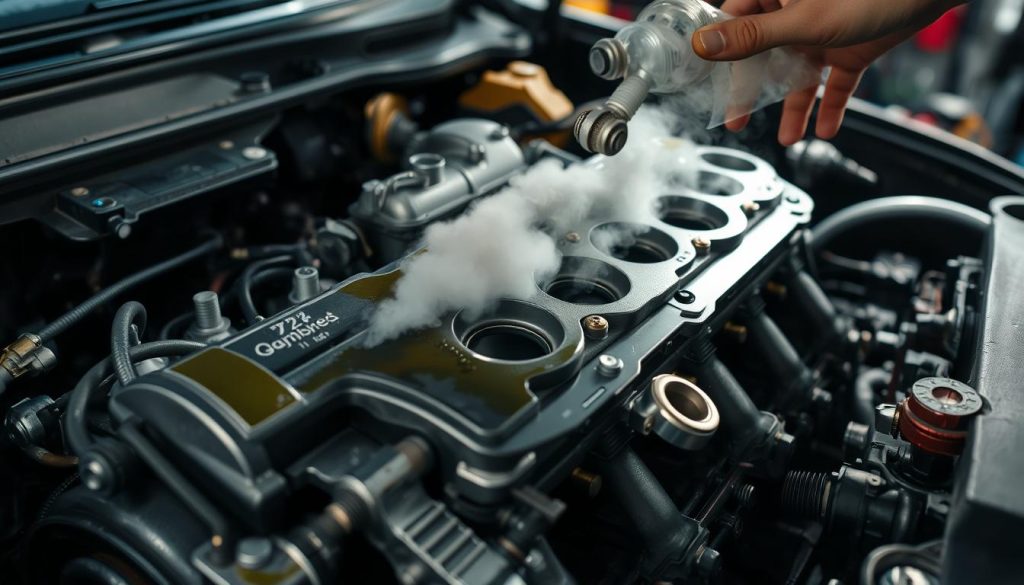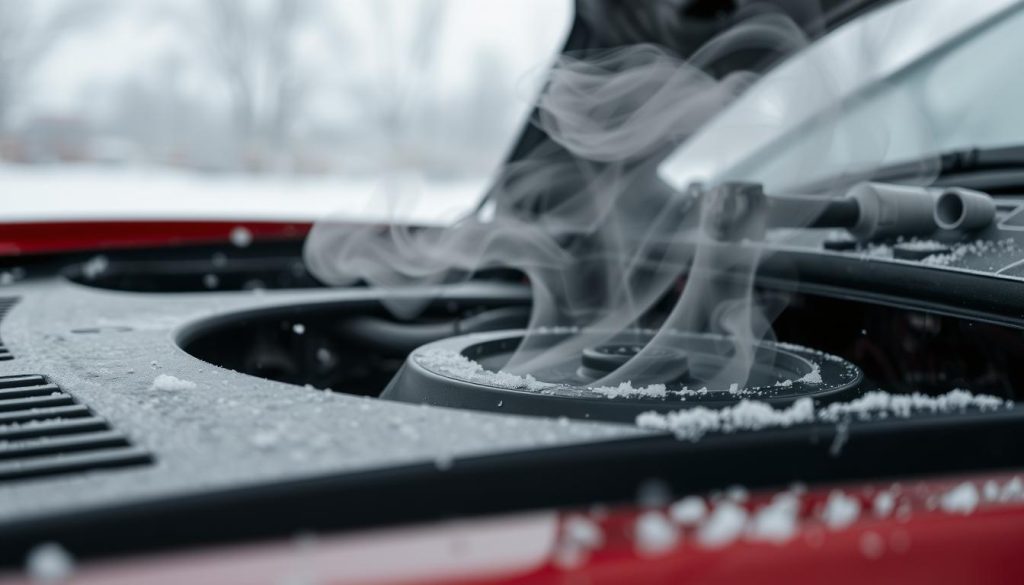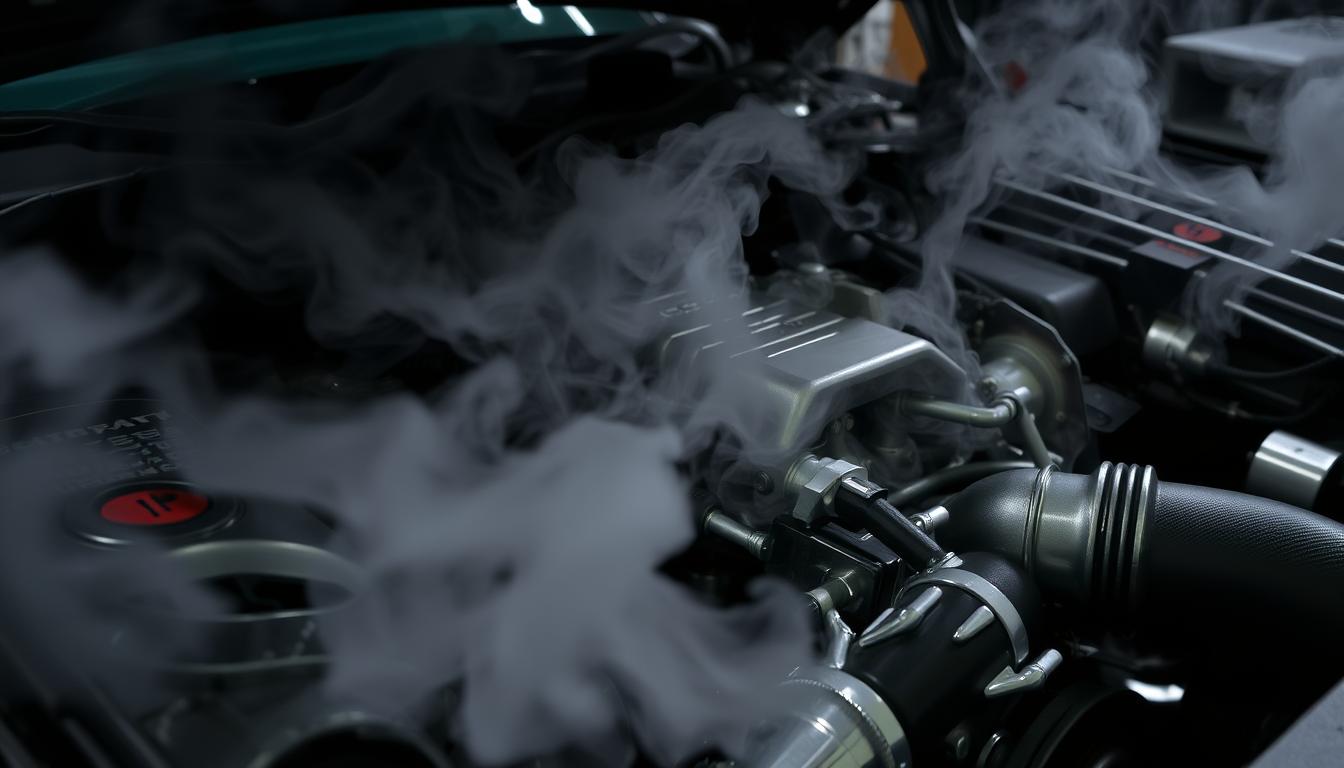Car engine smoke often signals underlying issues. It’s not typical for vehicles to emit clouds of smoke while in motion. This phenomenon typically indicates engine problems that require prompt attention. The color of the smoke can reveal specific automotive concerns, aiding in vehicle diagnostics and maintenance.
Identifying smoke early can avert expensive repairs. It serves as a critical indicator of something amiss beneath the hood. Whether it’s white, blue, or black, each smoke color conveys information about your vehicle’s condition. Let’s explore the reasons behind car engine smoke and its implications for your vehicle’s health.
Key Takeaways
- Engine smoke is a warning sign of possible car problems
- Smoke color can indicate specific engine issues
- Early detection of smoke can prevent major repairs
- Regular vehicle diagnostics help identify smoke causes
- Understanding smoke signals is essential for car maintenance
Understanding Different Types of Engine Smoke Colors
Exhaust smoke colors can reveal a lot about your car’s health. We will explore the meanings behind white smoke, blue smoke, black smoke, and gray smoke for your engine.
White Smoke from Exhaust
White smoke often signals coolant issues. If you observe thick white smoke, it could indicate that your engine is burning coolant. This could be due to a cracked head gasket or engine block. Such issues require immediate attention to prevent severe damage.
Blue Smoke Emissions
Blue smoke typically signals that your engine is burning oil. This can be due to worn piston rings or valve seals, allowing oil to seep into combustion chambers. Not only does this waste oil, but it can also harm your engine over time.
Black Smoke Indicators
Black smoke points to a rich fuel mixture. This can be caused by your engine receiving too much fuel or not enough air. Possible causes include a clogged air filter, faulty fuel injectors, or sensor issues.
Gray Smoke Signals
Gray smoke can be challenging to diagnose. It might indicate mild oil burning or transmission fluid leaks. In some cases, it could be a mix of oil and coolant burning together.
| Smoke Color | Possible Cause | Severity |
|---|---|---|
| White | Coolant leak | High |
| Blue | Oil burning | Medium |
| Black | Rich fuel mixture | Medium |
| Gray | Oil or transmission fluid | Medium to High |
Understanding these exhaust smoke colors can help you spot issues early. If you notice unusual smoke, it’s wise to consult a mechanic promptly.
Common Causes of Car Engine Smoke
Understanding the primary causes of engine smoke is essential for swift diagnosis. This section delves into the most prevalent reasons behind smoke emanating from your vehicle’s engine.
Blown Head Gasket Issues
A blown head gasket is a critical problem that frequently results in engine smoke. Failure of this gasket permits the mixing of oil and coolant, leading to white or blue smoke from the exhaust. Such an issue can cause overheating and substantial damage if not resolved immediately.

Oil Leaks and Burning
Oil leaks are a common source of engine smoke. When oil drips onto hot engine components, it burns, producing blue smoke. This can stem from worn valve seals, piston rings, or other engine parts. Regular oil changes and inspections are vital to prevent these problems.
Coolant System Problems
Coolant system issues often manifest as white smoke from the exhaust. This happens when coolant leaks into the combustion chamber and burns with the fuel. Common causes include a cracked engine block, damaged cylinder head, or a leaking head gasket.
| Smoke Color | Likely Cause | Potential Risks |
|---|---|---|
| White | Coolant leak | Engine overheating, severe damage |
| Blue | Oil burning | Engine wear, decreased performance |
| Gray | Transmission fluid leak | Transmission damage, poor shifting |
Early identification of these common engine smoke causes can avert expensive repairs. If you observe any unusual smoke, it is advisable to seek a professional mechanic for a detailed diagnosis and effective repair.
Diagnosing Smoke Problems Based on Driving Conditions
Understanding your car’s behavior in various driving conditions is essential for effective engine smoke diagnosis. Smoke troubleshooting can reveal a lot about your engine’s health. This is true when you observe when and how the smoke appears.
| Driving Condition | Smoke Behavior | Possible Issue |
|---|---|---|
| Cold Start | White smoke that clears quickly | Normal condensation |
| Idling | Continuous blue smoke | Worn valve seals |
| Acceleration | Black smoke puffs | Rich fuel mixture |
| Cruising | Steady white smoke | Coolant leak |
| Deceleration | Blue smoke trail | Worn piston rings |
During cold starts, a brief puff of white smoke is normal due to condensation. If it persists, you might have a coolant leak. Blue smoke while idling often points to worn valve seals, allowing oil to seep into the combustion chamber.
When accelerating, black smoke suggests an overly rich fuel mixture. This could be due to a faulty oxygen sensor or fuel injectors. Steady white smoke while cruising at highway speeds might indicate a serious issue like a blown head gasket.
“Pay attention to when the smoke appears and its color. These clues are critical for accurate engine smoke diagnosis.”
By observing these patterns, you can provide valuable information to mechanics, making smoke troubleshooting more efficient. Remember, persistent smoke in any driving condition warrants immediate attention to prevent further engine damage.
The Impact of Weather on Engine Smoke Production
Weather significantly influences your car’s engine performance. Different conditions, from cold starts to hot summer drives, can impact smoke production and engine function.
Cold Weather Effects
Cold weather can lead to increased smoke during engine startup, a common issue in winter. As temperatures decrease, oil thickens, hindering its circulation. This results in a brief white smoke puff from the exhaust as the engine warms up.

Hot Climate Considerations
Hot weather poses its own set of engine challenges. High temperatures cause oil to thin, potentially increasing oil consumption and leading to blue smoke from the exhaust. Overheating becomes a significant concern, stressing various engine components.
Humidity Factors
Humidity also affects engine performance. In moist conditions, you might observe more visible exhaust vapor, which can be mistaken for smoke. High humidity can also impact fuel combustion efficiency, potentially leading to increased emissions.
| Weather Condition | Smoke Color | Potential Issue |
|---|---|---|
| Cold | White | Condensation, thick oil |
| Hot | Blue | Oil burning, overheating |
| Humid | White/Gray | Water vapor, inefficient combustion |
Understanding these weather-related effects can help you better interpret and address engine smoke issues. This ensures your vehicle runs smoothly in all conditions.
Car Engine Warning Signs Beyond Smoke
Your car’s engine can exhibit warning signs before smoke appears. Recognizing these signals early can prevent costly repairs. Let’s explore key engine warning signs to watch for.
Unusual Engine Sounds
Engine noises can signal trouble. A knocking sound might indicate worn bearings. Ticking noises could suggest low oil levels. Hissing often points to a leak in the cooling system. It’s vital to pay attention to these unusual engine noises and address them promptly.
Performance Changes
Notice how your car drives. Reduced power, poor acceleration, or decreased fuel economy are performance issues that shouldn’t be ignored. These changes can stem from various problems, from clogged filters to serious engine damage.
Dashboard Warning Lights
Your dashboard is a wealth of information. The check engine light is a catch-all for many issues. Oil pressure and temperature lights warn of potentially severe problems. Don’t overlook these dashboard indicators – they’re your first line of defense against major breakdowns.
- Check engine light: Scan for error codes
- Oil pressure light: Check oil levels immediately
- Temperature light: Look for coolant leaks or fan issues
Remember, addressing these engine warning signs early can prevent smoke and more serious damage. Regular maintenance and prompt attention to changes in your car’s behavior are key to a healthy engine.
Immediate Actions When You Notice Engine Smoke
Spotting smoke from your car’s engine necessitates swift action for vehicle safety. Your response to engine smoke can significantly influence preventing further damage and ensuring your safety on the road.
Initially, remain calm and adhere to these emergency car procedures:
- Safely pull over to the side of the road, away from traffic
- Turn off the engine immediately
- Turn on your hazard lights to alert other drivers
- Exit the vehicle if it’s safe to do so
- Open the hood cautiously, watching for hot steam or smoke
After these initial steps, evaluate the situation. If the smoke is dense or accompanied by unusual noises, refrain from restarting your car. Instead, contact roadside assistance or a tow truck.
In milder cases, such as thin white smoke on a cold day, it might be condensation. Wait a few minutes and then start the engine. If the smoke dissipates rapidly, you might proceed with caution.
“Your safety should always come first. When in doubt, it’s better to err on the side of caution and seek professional help.”
Remember, prompt action in response to engine smoke can prevent minor issues from escalating. By following these steps, you’ll be better equipped to manage unexpected situations and uphold your vehicle’s safety.
Prevention and Maintenance Tips
Maintaining your car’s engine is essential to prevent smoke and ensure smooth operation. We will discuss critical preventive car care strategies to preserve your engine’s health.
Regular Oil Changes
Regular oil changes are fundamental for engine care. Fresh oil ensures lubrication and prevents engine wear. Adhere to your car’s recommended oil change interval, usually every 3,000 to 5,000 miles.
Cooling System Upkeep
Effective cooling system maintenance is critical to prevent overheating. Regularly check coolant levels and flush the system as advised by your car’s manufacturer. This action prevents coolant leaks and maintains the engine’s optimal temperature.
Engine Component Checks
Regular inspections of engine components can identify issues early. Examine belts, hoses, and spark plugs for wear signs. Replace air filters as needed to ensure clean air intake. These actions significantly contribute to preventive car care.
“An ounce of prevention is worth a pound of cure when it comes to engine maintenance.”
Adhering to these guidelines will ensure your engine remains in optimal condition, reducing smoke-related issues. Consistent engine maintenance is the most effective way to prolong your car’s lifespan and avoid expensive repairs in the future.
When to Seek Professional Help
Dealing with engine smoke can be a complex challenge. At times, it’s imperative to seek the expertise of professionals. Let’s explore the scenarios where professional auto repair is necessary and why it’s critical.
Emergency Situations
Thick smoke or a car that shakes violently necessitates an immediate stop. These symptoms indicate severe engine malfunctions. It’s not advisable to attempt repairs yourself. Instead, contact car emergency services to ensure your safety and prevent further engine damage.
Diagnostic Services
Struggling to identify the source of engine smoke? Engine diagnostics can be your savior. Mechanics employ advanced tools to uncover hidden issues. They can identify problems that might elude you, preventing them from escalating.
Seeking professional assistance early can significantly reduce long-term costs. Skilled auto repair technicians are equipped to handle complex engine problems. They will expedite your return to safe driving, ensuring your vehicle’s longevity.

Leave a Reply